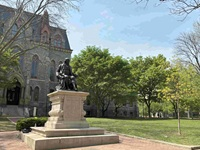Speaker
Description
As SuperKEKB approaches its target instantaneous luminosity of $6\times 10^{35}$ cm$^{-2}$ s$^{-1}$, its only particle detector, Belle II comprised of several subdetectors*, is also undergoing constant upgrades and changes. Closer to its target luminosity, the Belle II detector expects to receive very large data samples that have much higher background and radiation levels. Single event upsets (SEU) due to neutrons and charged particles have been known to lock up the Time of Propagation (TOP) subdetector’s on-chip processing system (PS), a part of the Xilinx Zync SoC. By migrating the existing functionality of the PS to the readout servers for the TOP subdetector, we will prevent PS lockups from stopping Belle II data acquisition (DAQ), as the readout servers at Belle II are in a radiation-safe zone, close to the detector. In addition, this opens new pathways for using more advanced data-processing techniques, including AI/ML-based feature extraction in the future.
The current functionalities of the PS include feature extraction (features like pulse height, width, position, rise and fall times, etc.), data reduction, and re-formatting. Feature extraction in the PS currently utilizes the Constant Fraction Discrimination (CFD) method to extract these features from the raw waveforms. After migrating these functionalities to the readout servers, the role of PS in data-taking is completely removed, thus avoiding any downtime during DAQ due to PS lockups. Further improvements by replacing the CFD method with a trained machine learning (ML) model to extract these features more precisely, e.g., using template fitting, etc., can be made. Similarly, ML models trained on these waveform features may be used to classify events and thus reduce noise. I will report on the status and compare performance post-migration of these functionalities from PS to the readout servers for the TOP detector at the workshop.
*https://www.belle2.org/research/detector/

